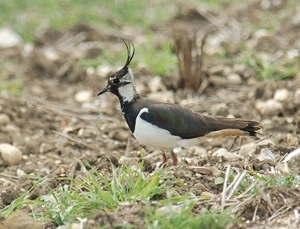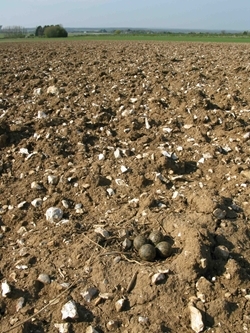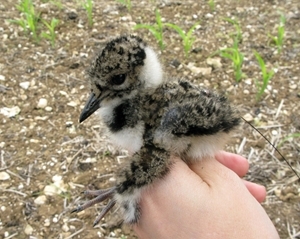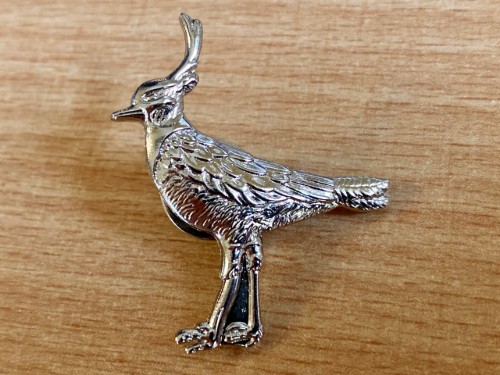 The lapwing is an iconic but rapidly declining farmland bird, whose numbers have fallen by 50% since 1983 (CBC/BBS joint trend), and which is now ‘red-listed’ as a bird of conservation concern. It is on the UK BAP list of priority species owing to international threat status, as well as the marked decline in the UK. One of the main factors behind the decline has been the widespread switch from spring-sown to autumn-sown crops since the 1970s, which has dramatically reduced the availability of suitable nesting habitat. In the late 1990s, 39% of breeding lapwings in England and Wales were recorded on arable farmland, with 85% of these on spring tillage, and a further 5% on set aside. Analysis of adult survival rate indicated no appreciable change during this period and suggests that insufficient productivity is the main driver of lapwing declines.
The lapwing is an iconic but rapidly declining farmland bird, whose numbers have fallen by 50% since 1983 (CBC/BBS joint trend), and which is now ‘red-listed’ as a bird of conservation concern. It is on the UK BAP list of priority species owing to international threat status, as well as the marked decline in the UK. One of the main factors behind the decline has been the widespread switch from spring-sown to autumn-sown crops since the 1970s, which has dramatically reduced the availability of suitable nesting habitat. In the late 1990s, 39% of breeding lapwings in England and Wales were recorded on arable farmland, with 85% of these on spring tillage, and a further 5% on set aside. Analysis of adult survival rate indicated no appreciable change during this period and suggests that insufficient productivity is the main driver of lapwing declines.
The main government-funded delivery mechanisms for reversing the declines in farmland bird populations are agri-environment schemes. Fallow plots for ground-nesting birds are currently provided through agreements under Countryside Stewardship (OS3, now closed to entrants), Higher Level Stewardship (HF13 & HF17), and now through a new Entry Level Stewardship option (EF13). They are available in the new Welsh AES, Glastir.
These options allow for the creation of un-cropped plots of at least 2 ha (1ha for EF13) within arable fields by cultivating the plot in spring to produce rough fallow. These options are designed to provide both nesting and foraging opportunities for lapwings. This focus on the lapwing is justified by its listing on Section 41 of the NERC Act (2006) and the Government’s England Biodiversity Strategy (EBS) Outcome 3 which seeks an overall improvement in the status of species by 2020. Through EBS Outcome 1, the Government is committed to a significant increase in arable options (including fallow plots), as part of the 200,000 ha target, by 2020 and it will be essential to ensure effectiveness and value for money.
 An estimated 40% of fallow plots within agri-environment schemes are used by breeding lapwings, but there is a dearth of information on breeding success on these plots. During the Arable Stewardship Pilot Scheme, nesting lapwing densities and hatching success were higher on option OS3 than on arable crops. However, following roll-out within agri-environment schemes, anecdotal reports from farmland advisors suggest that lapwing productivity on fallow plots may be low. RSPB data from a large sample (n = 247-266) of stone curlew plots in Hampshire, Wiltshire and Berkshire indicate a 50% decline in numbers of lapwing pairs between 2006 and 2012. Data collected by GWCT on 79 fallow plots during 2010-2011 suggest nest survival of 57% (95% CL 44-74%), but average brood survival of only 19% (95% CL 11-32%). Overall productivity was estimated at approximately 0.38-0.48 fledged young per female, which is too low for maintenance of stable lapwing populations.
An estimated 40% of fallow plots within agri-environment schemes are used by breeding lapwings, but there is a dearth of information on breeding success on these plots. During the Arable Stewardship Pilot Scheme, nesting lapwing densities and hatching success were higher on option OS3 than on arable crops. However, following roll-out within agri-environment schemes, anecdotal reports from farmland advisors suggest that lapwing productivity on fallow plots may be low. RSPB data from a large sample (n = 247-266) of stone curlew plots in Hampshire, Wiltshire and Berkshire indicate a 50% decline in numbers of lapwing pairs between 2006 and 2012. Data collected by GWCT on 79 fallow plots during 2010-2011 suggest nest survival of 57% (95% CL 44-74%), but average brood survival of only 19% (95% CL 11-32%). Overall productivity was estimated at approximately 0.38-0.48 fledged young per female, which is too low for maintenance of stable lapwing populations.
Based on annual survival rates of 83% and 60% for adults and first-year birds respectively, it has been estimated that each pair needs to fledge on average 0.7 young per annum to maintain a stable population. Comparison with GWCT data for wet grassland within the Avon Valley (Hampshire, Dorset) in the same years indicates that nest survival on fallow plots is higher but brood survival lower. Poor chick survival therefore seems to be limiting lapwing productivity on fallow plots in the Hampshire-Wiltshire-Dorset area.
Despite considerable investment in habitat improvement through AES, it is possible that lapwing numbers are not increasing on many farms owing to low food availability for chicks or high predation rates (on nests and/or chicks). Most research to date has been conducted on wet grassland nature reserves, where high predator densities can result in poor breeding success of lapwings, but the situation in the wider countryside, where lapwings are typically nesting at lower densities, may be different. We believe that in the arable landscape, poor chick survival through starvation may be equally or more important. The fallow plots and surrounding arable crops may simply provide insufficient food, typically beetles and insect larvae in grassland areas, although the diet in arable areas has been little studied. Chick survival has been poorly researched because it is more difficult than monitoring of nests, but understanding how to increase brood survival may be crucially important for the long-term maintenance of lapwing populations. In common with most AES, population-level effects have not been evaluated, though they should be one of the goals of schemes.
Fallow plots are among the most expensive ‘per hectare payment’ arable AES options. If we are to reverse the decline of this farmland bird then it is essential to evaluate whether the fallow plot options are producing sufficient fledged chicks and whether there is scope for increasing their effectiveness. Without such evidence, it is impossible to know whether fallow plots are a suitable agri-environment option for this species, or to suggest improvements to plot management or location that are likely to improve breeding success and, hence, their effectiveness.
 The GWCT is leading a Defra-funded project with the RSPB to assess the efficacy of AES fallow plots as a tool for lapwing recovery in lowland arable/mixed farming landscapes. Research is being conducted by the GWCT in Hampshire, Wiltshire and Dorset and by the RSPB in Cambridgeshire and Norfolk. Specific objectives are:
The GWCT is leading a Defra-funded project with the RSPB to assess the efficacy of AES fallow plots as a tool for lapwing recovery in lowland arable/mixed farming landscapes. Research is being conducted by the GWCT in Hampshire, Wiltshire and Dorset and by the RSPB in Cambridgeshire and Norfolk. Specific objectives are:
- Assessment of overall breeding success on fallow plots and comparison with arable fields without AES measures.
- Estimation of lapwing nest survival on a minimum of 40 fallow plots per annum and comparison with nest survival on spring cereal fields.
- Analysis of distances moved and habitat use relative to availability by 40 broods hatching on fallow plots and 20 broods hatching on spring cereals per annum.
- Determination of chick invertebrate diet from faecal samples in relation to invertebrate availability.
- Estimation of chick survival and determination of the relative importance of starvation and predation as causes of chick mortality, including investigation of situations resulting in poor chick condition and growth rates and situations where there are high rates of predation.

Get your GWCT Lapwing Badge for £9.99
£5 from the sale of each badge goes directly to our Wader Tracking Appeal
You can support our biggest tracking project yet and help curlew, lapwing and woodcock with our brand new lapwing pin badge. £5 from the sale of each badge goes toward this vital project. Badge measures approx 3cm x 3.5cm.
View Badge >
or
Buy Now - £9.99 >
100% Secure. All Credit & Debit cards, PayPal, Apple Pay and Google Pay accepted.
